Abstract
The distribution of end-plate lesions (Schmorl's nodes) and their relationship to bone density and disc degeneration have been studied in 50 post-mortem spines below D9 in subjects aged 13-96 years. Lesions were present in 76% of cases with a predominance in males. They were found more frequently in the lower than in the upper vertebral end-plate. They were also more common and more severe in the dorsolumbar (D10-L1) region than in the lower lumbar (L2-L5 region). In adults they were unrelated to age and bone density. Lesions were significantly related to disc degeneration in the D10-L1 region but not in the L2-L5 region. It is suggested that end-plate lesions arising in adolescence (or before) may predispose the dorsolumbar spine to disc degeneration in later life.
Full text
PDF





Images in this article
Selected References
These references are in PubMed. This may not be the complete list of references from this article.
- Atkinson P. J., Woodhead C. Changes in human mandibular structure with age. Arch Oral Biol. 1968 Dec;13(12):1453–1464. doi: 10.1016/0003-9969(68)90027-7. [DOI] [PubMed] [Google Scholar]
- Vernon-Roberts B., Pirie C. J. Healing trabecular microfractures in the bodies of lumbar vertebrae. Ann Rheum Dis. 1973 Sep;32(5):406–412. doi: 10.1136/ard.32.5.406. [DOI] [PMC free article] [PubMed] [Google Scholar]




